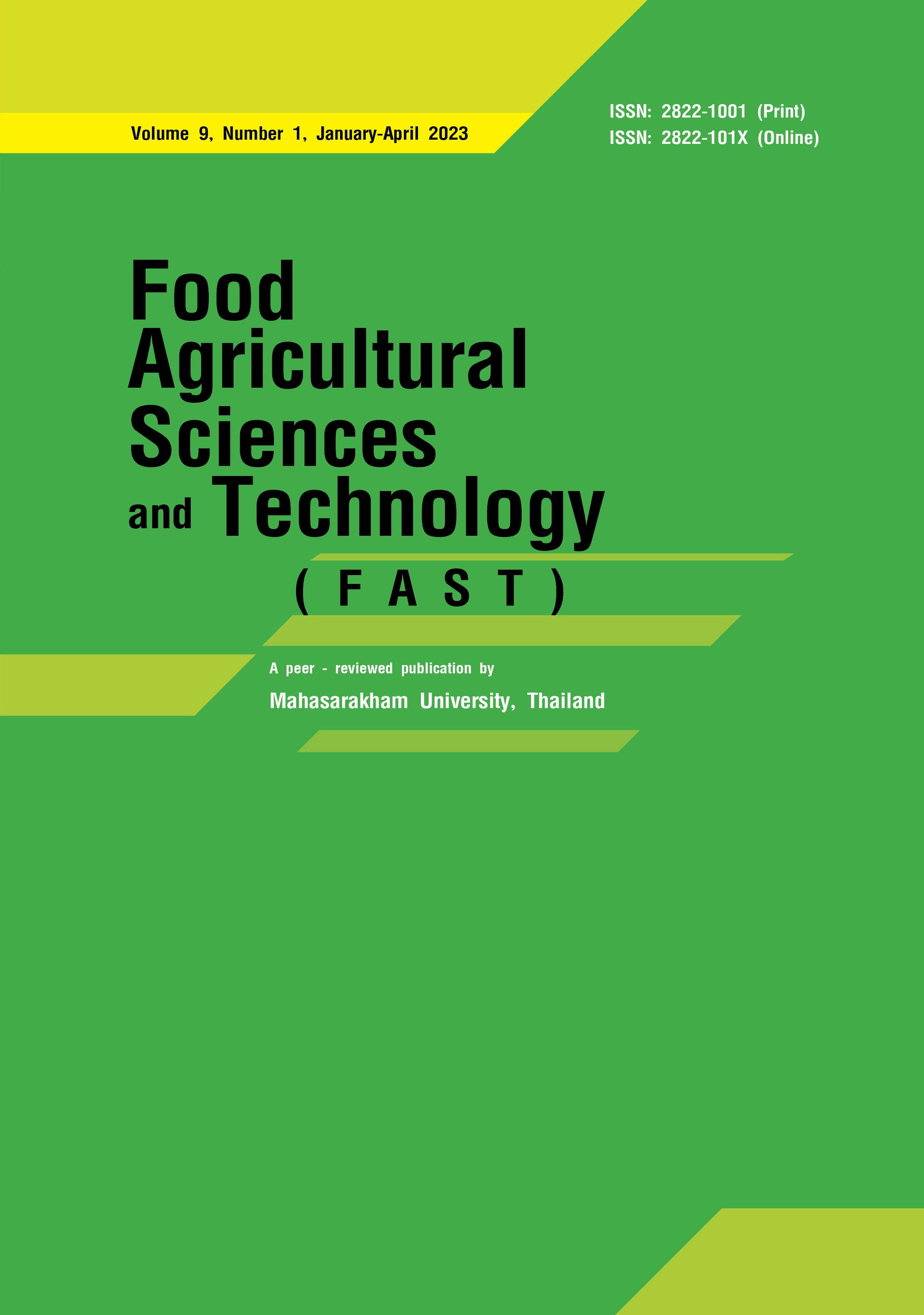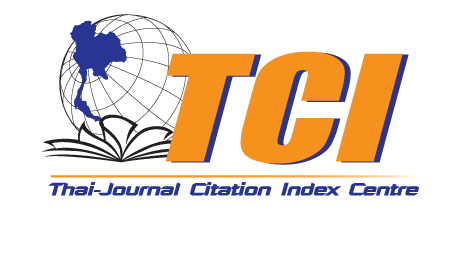Extraction and characterization of pectin from selected indigenous fruits for further commercial application in food industries
Keywords:
Pectin, Breadfruit (Artocarpus altilis L.), Papaya (Carica papaya L.), Santol (Sandoricum indicum Cav.), Indigenous fruit, Acid extractionAbstract
The aims of this study were to extract pectin from selected indigenous fruits, including breadfruit, papaya and santol as well as investigate the chemical and physical properties of extracted pectin to address the potential of these fruits as an alternative source of commercial pectin. Different parts of fruits were used to extract pectin under the acid condition method. Pectin yield ranged from 8.52±0.05 to 49.96±0.89% and breadfruit was the highest pectin source. The extracted pectin from breadfruit was categorized as high methoxyl pectin with the degree of esterification between 93.57±0.22 to 96.70±0.17%, which was almost 2-time higher than the commercial pectin (53.10±1.25%). The galacturonic acid contents found in the extracted pectin varied widely from 41.41±0.09 to 73.19±0.59%. The significantly highest galacturonic acid content was found in the pectin extracted from the peel of breadfruit, which strongly indicated that pectin extracted from the peel of breadfruit was good quality. The FT-IR spectra also confirmed that the pectin obtained in this study was overall similar to the commercial pectin. Therefore, the breadfruit peel was highly recommended as a potential alternative source of pectin.
References
Ahmmed, R., Inam, A., Alim, M., Sobhan, M., Haque, M. J. J. o. E. S., & Resources, N. (2017). Extraction, characterization and utilization of pectin from jackfruit (Artocarpus heterophyllus L.) waste. Journal of Environmental Science and Natural Resources, 32, 57-66.
AOAC. (2000). Official methods of analysis (17 ed.). Association of official analytical chemists: Arlington, Virginia, USA.
Azad, A., Ali, M., Akter, M. S., Rahman, M. J., Ahmed, M. J. J. o. F., & Sciences, N. (2014). Isolation and characterization of pectin extracted from lemon pomace during ripening. Journal of Food and Nutrition Sciences, 2(2), 30-35.
Bichara, L. C., Alvarez, P. E., Fiori Bimbi, M. V., Vaca, H., Gervasi, C., & Brandán, S. A. (2016). Structural and spectroscopic study of a pectin isolated from citrus peel by using FTIR and FT-Raman spectra and DFT calculations. Infrared Physics & Technology, 76, 315- 327. doi:https://doi.org/10.1016/j. infrared. 2016.03.009.
Burana-osot, J., Soonthornchareonnon, N., Chaidedgumjorn, A., Hosoyama, S., & Toida, T. (2010). Determination of galacturonic acid from pomelo pectin in term of galactose by HPAEC with fluorescence detection. Carbohydrate Polymers, 81(2), 461-465. doi:https://doi. org/10.1016/j.carbpol. 2010.03.001.
Castillo-Israel, K. A. T., Baguio, S. F., Diasanta, M. D. B., Lizardo, R. C. M., Dizon, E. I., & Mejico, M. I. F. J. i. f. r. j. (2015). Extraction and characterization of pectin from Saba banana [Musa 'saba' (Musa acuminata × Musa balbisiana)] peel wastes: a preliminary study. International Food Research Journal, 22, 202-207.
do Nascimento Oliveira, A., de Almeida Paula, D., Basílio de Oliveira, E., Henriques Saraiva, S., Stringheta, P. C., & Mota Ramos, A. (2018). Optimization of pectin extraction from Ubá mango peel through surface response methodology. International Journal of Biological Macromolecules, 113, 395-402. doi:https://doi.org/10.1016/j.ijbioma c.2018.02.154.
Filippov, M. (1992). Practical infrared spectroscopy of pectic substances. Food Hydrocolloids, 6(1), 115-142. doi:https://doi.org/10.1016/S0268- 005X(09)80060-X.
Ismail, N. S. M., Ramli, N., Hani, N. M., & Meon, Z. J. S. M. (2012). Extraction and characterization of pectin from dragon fruit (Hylocereus polyrhizus) using various extraction conditions. Sains Malaysiana, 41(1), 41-45.
Ji-u, P., & Neamsorn, N. J. J. o. F. T., Siam University. (2022). Effect of Extraction Methodson Physical and Chemical Properties of Pectin from Overripe 'Namwa' Banana. Journal of Food Technology, Siam University, 17(1), 26-36.
Joye, D., & Luzio, G. J. C. P. (2000). Process for selective extraction of pectins from plant material by differential pH. Carbohydrate Polymers, 43(4), 337-342.
Kalapathy, U., & Proctor, A. (2001). Effect of acid extraction and alcohol precipitation conditions on the yield and purity of soy hull pectin. Food Chemistry, 73(4), 393- 396. doi:https://doi.org/10.1016/ S0308-8146(00)00307-1.
Kamnev, A. A., Colina, M., Rodriguez, J., Ptitchkina, N. M., & Ignatov, V. V. (1998). Comparative spectroscopic characterization of different pectins and their sources. Food Hydrocolloids, 12(3), 263-271. doi:https://doi.org/10.1016/S0268- 005X(98)00014-9.
Khamsucharit, P ., Laohaphatanalert, K., Gavinlertvatana, P., Sriroth, K., & Sangseethong, K. (2018). Characterization of pectin extracted from banana peels of different varieties. Food Sci Biotechnol, 27(3), 623-629. doi:10.1007/ s10068-017-0302-0
Kozioł, A., Środa-Pomianek, K., Górniak, A., Wikiera, A., Cyprych, K., & Malik, M. (2022). Structural determination of pectins by spectroscopy methods. Coatings, 12(4). doi:10.3390/coatings 12040546.
Kyomugasho, C., Christiaens, S., Shpigelman, A., Van Loey, A. M., & Hendrickx, M. E. (2015). FT-IR spectroscopy, a reliable method for routine analysis of the degree of methylesterification of pectin in different fruit- and vegetable-based matrices. Food Chem, 176, 82-90. doi:10.1016/j. foodchem. 2014.12.033.
Mesbahi, G., Jamalian, J., & Farahnaky, A. (2005). A comparative study on functional properties of beet and citrus pectins in food systems. Food Hydrocolloids, 19(4), 731- 738. doi:https://doi.org/10.1016/j. foodhyd. 2004.08.002.
Mollea, C., Chiampo, F., & Conti, R. (2008). Extraction and characterization of pectins from cocoa husks: A preliminary study. Food Chemistry, 107(3), 1353- 1356. doi:https://doi.org/10.1016/j. foodchem. 2007.09.006.
Muhammad, K., Zahari, N. I. M., Gannasin, S. P., Adzahan, N. M., & Bakar, J. J. F. h. (2014). High methoxyl pectin from dragon fruit (Hylocereus polyrhizus) peel. Food hydrocolloids, 42, 289-297.
Ranganna, S. (1986). Handbook of analysis and quality control for fruit and vegetable products. Tata McGrawHill Education.
Santos, J. D. G., Espeleta, A. F., Branco, A., & de Assis, S. A. (2013). Aqueous. extraction of pectin from sisal waste. Carbohydrate Polymers, 92(2), 1997-2001. doi:https://doi.org/ 10.1016/j.carbpol. 2012.11.089
Sikder, M. B. H., Ahmed, S. J. F., & Journal, A. B. (2019). Extraction, characterization and application of three varieties of Citrus limon L. pectin in jelly product. Food and Applied Bioscience Journal, 7(1), 31-50.
Singthong, J., Cui, S. W., Ningsanond, S., & Douglas Goff, H. (2004). Structural characterization, degree of esterification and some gelling properties of Krueo Ma Noy (Cissampelos pareira) pectin. Carbohydrate Polymers, 58(4), 391- 400. doi:https://doi.org/10.1016/j. carbpol. 2004.07.018.
Yang, J.-S., Mu, T.-H., & Ma, M.-M. (2018). Extraction, structure, and emulsifying properties of pectin from potato pulp. Food Chemistry, 244, 197- 205. doi:https://doi.org/10.1016/j. foodchem. 2017.10.059.
Downloads
Published
How to Cite
Issue
Section
License
Copyright (c) 2023 Food Agricultural Sciences and Technology (FAST)

This work is licensed under a Creative Commons Attribution-NoDerivatives 4.0 International License.







